Canada's Newest National Park Is Only Accessible by Floatplane or Snowmobile
This wild, pristine corner of Canada’s Northwest Territories is also considered sacred ground by the Indigenous people who are stewards of the land.
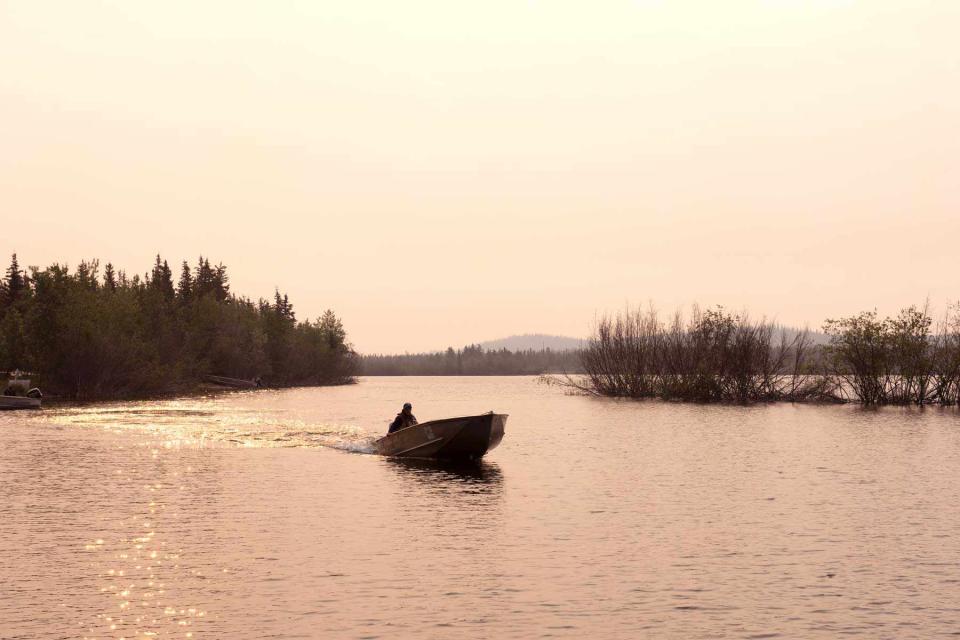
Pat Kane
Peter Enzoe on the water in his boat.You either love the North or you don’t. I love the North and always have. Since I was young I’ve been magnetized by it, compass-like. My inner needle points to where the roads end — and then beyond. I’ve paddled solo from my home, on the Leech Lake Reservation in Minnesota, 250 miles north to Rainy Lake. I’ve taken weeks-long canoe trips with my brother and my friends on the Berens and Bloodvein rivers, which flow from Ontario northwest into Lake Winnipeg. And I once spent an entire winter in northwestern Ontario’s boreal forest trapping beavers and pine marten. So it was with massive excitement that I traveled last July as far north from Minnesota as Guadalajara is south: to Canada’s newest national park, Thaidene Nëné, in the Northwest Territories.
Thaidene Nëné National Park Reserve encompasses more than 5,400 square miles on the eastern side of Great Slave Lake, the deepest lake in North America. It is shockingly remote. The park is contained within the Thaidene Nëné Indigenous Protected Area, which is bordered on the northeast by the Thaidene Nëné Wildlife Conservation Area; both are part of an Indigenous Protected Area. What this means broadly is that all of that land — once threatened by diamond and uranium mining — is safe from development. What it means specifically is that the park and the lands around it are administered and managed by the Łutsël K’é Dene First Nation, the government of the Northwest Territories, Parks Canada, and other Indigenous governments including the Northwest Territory Métis Nation, Deninu Kųę́ First Nation, and Yellowknives Dene First Nation.
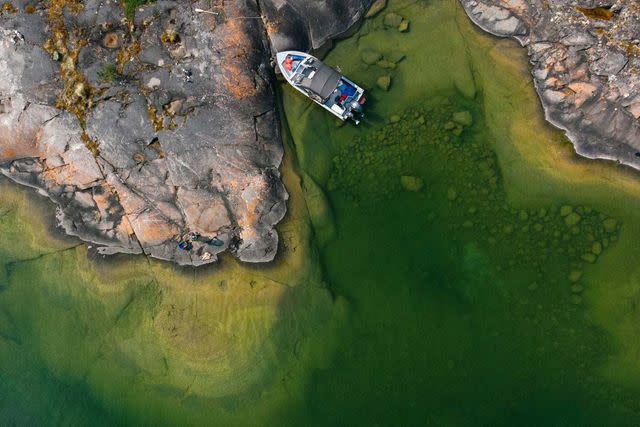
Pat Kane
An aeril view of Wildbread Bay, part of Thaidene Nene ParkIn short, Thaidene Nëné — which means “Land of the Ancestors” in the Dene language — is big, and not just undeveloped but almost “anti-developed.” There are no designated campgrounds, no picnic tables, no trails, concession stands, or even roads to the park. To get there you have to fly from Yellowknife, the capital of the Northwest Territories, to the airport in the village of Łutsël K’é, and then take a boat or snowmobile to the park border. Getting there is hard. Being there is a different kind of hard. And this is where the fact that you either love the North or don’t comes into play.
I don’t normally like flying, but I liked the flight from Vancouver to Yellowknife because I got to chase the sun: in June and much of July it doesn’t get truly dark on the 62nd parallel. (The only other “notable” place I could find on my map at that latitude is the Faroe Islands.) And so, mile after mile, as the sun hovered on the horizon, I was able to look out the window at the seemingly endless lakes and boreal forest. The farther north I traveled the smaller and more patchy the trees became.
Thaidene Nëné National Park Reserve encompasses more than 5,400 square miles on the eastern side of Great Slave Lake, the deepest lake in North America. It is shockingly remote. There are no designated campgrounds, no picnic tables, no trails, concession stands, or even roads to the park. To get there you have to fly from Yellowknife, the capital of the Northwest Territories, to the airport in the village of Łutsël K’é, and then take a boat or snowmobile to the park border
I found Yellowknife strange and alluring. The population of the Northwest Territories is around 43,000, and half of those people live in Yellowknife. The city was settled in the 1930s, after the first visible vein of gold was discovered in the area, and incorporated in 1970. You wouldn’t think a city 250 miles from the Arctic Circle would be diverse. But roughly 25 percent of the population is First Nations, Métis, or Inuit; there are 11 official languages and nearly 70 other languages spoken there. From the moment I arrived in Yellowknife, I felt in my bones that I was in a place where, for once, I was part of a majority. And it felt good.
Time starts to fall away the farther north you get. After a short night’s rest I took a taxi (driven by an African-Canadian) across Yellowknife to the air terminal run by Air Tindi, which serves many remote communities. Its planes have tires to land on dirt runways and floats and skis to land on lakes. As I checked in, I noticed that the baggage handlers were Native, the desk agents were Native, and the majority of the seven passengers were Native. This is another thing I love about the North. Members of my tribe, the Ojibwe, are vested in our northern identity as much as in our sense of ourselves as a tribe, and I feel safe, happy, and at ease when I’m around other Native people, especially northerners.
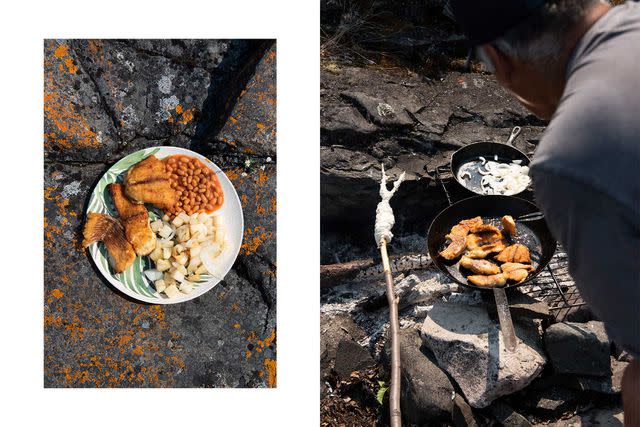
Pat Kane
From left: Trout, beans and potatoes cooked over an open fire near Wildbread Bay; Ron Desjarlais preparing lunch, including trout and bannock.At the Air Tindi terminal, I was joined by Pat Kane, an Anishinaabe photographer who lives in Yellowknife. When we touched down at Łutsël K’é an hour later, he checked his phone and said, “Before we head to the lodge, we should go to the dock. A buddy of mine from the village shot a musk ox yesterday, and they’re handing out meat to whoever wants it.”
Outside the airport we were met by James Stewart, one of the fishing guides at Frontier Lodge, where we would be staying for the next few days. After we threw our stuff in his truck, he drove us to the dock, where there was a table set up with musk ox meat divvied into gallon ziplock bags. (A few days later I would spot musk oxen in the wild, which confirmed that they are one of the strangest animals I’ve ever seen. They are large — a bull’s average weight is between 600 and 800 pounds, though they look much thicker because of their fur. Both males and females have horns. Their range is closely and exclusively circumpolar: they are unique to the Arctic.)
You wouldn’t think a city 250 miles from the Arctic Circle would be diverse. But roughly 25 percent of the population is First Nations, Métis, or Inuit; there are 11 official languages and nearly 70 other languages spoken there. From the moment I arrived in Yellowknife, I felt in my bones that I was in a place where, for once, I was part of a majority. And it felt good.
We chatted with the Ni Hat’ne Dene Guardians, the group that had hunted the animal. They function as supercharged park rangers, but their mandate is much broader than that. They assert the Łutsël K’é Dene First Nation authority and treaty rights over the traditional homelands, manage Dene sacred sites, and live a subsistence lifestyle, which includes harvesting musk oxen and giving the meat to anyone who wants some. We definitely wanted some.
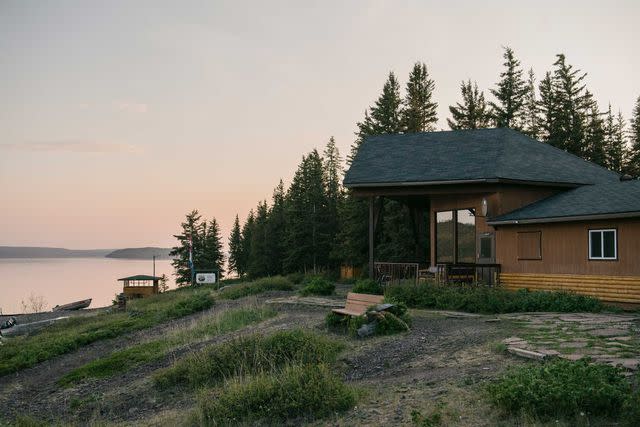
Pat Kane
Frontier Lodge, Thaidene Nëné’s primary accommodation.Not to sound too mystical about it, but the North isn’t necessarily a destination as much as a way of moving, a way of being, a habit. I felt this keenly as we headed out via skiff across the mouth of the Stark River. James negotiated the low water and rocks at top speed, and Great Slave Lake opened up in front of us in all its massive glory. The lake is all about scale: it’s the 10th largest in the world in terms of surface area and volume. Its size is everything, and moving across it in a boat, no matter how quickly, feels incredibly slow.
Frontier Lodge is an example of a distinctly Canadian phenomenon: the outpost lodge on a remote lake, reachable only by plane, floatplane, or boat. Frontier was built in the 1960s and purchased by the Łutsël K’é Dene First Nation in 2020. A central building, outfitted with a kitchen, a dining room, and a lounge, is surrounded by seven modest cabins. There is no pool. There is no game room. There is spotty cell service. The Wi-Fi is bad. There is, however, excellent trout fishing. And there are (fairly) affluent guests, mostly Americans and Canadians, who have paid a lot to travel to the top
of the world to fish.
After a quick lunch of cheeseburgers (since our flight was delayed, we missed the traditional Frontier Lodge welcome of fish chowder), Pat and I went fishing with Ron Desjarlais, a guide from Łutsël K’é with just about the nicest boat I’ve ever caught fish from. We powered up and took off from the dock out onto the lake and it opened up and kept opening and then kept opening some more.
I fished shallows. I sight-cast rock piles. I jigged 100 feet down. I trolled enormous spoons behind the boat. If you’re not into fishing it might be best to say: you can pretty much fish any way and anywhere you want on Great Slave Lake and you’re probably going to catch fish. I caught fish. So many fish it isn’t really accurate to call it “fishing.” On Great Slave it should just be called “catching.”
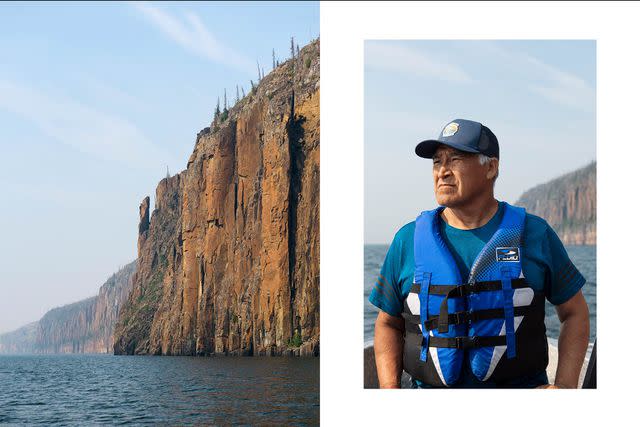
Pat Kane
From left: Red Cliff Island, in Canada’s Thaidene Nëné National Park Reserve, rises hundreds of feet from Great Slave Lake; fishing guide Ron Desjarlais near Red Cliff Island.Thaidene Nëné is a huge place. There is no headlining attraction — no geyser or mountain or waterfall — around which the park is arranged. Instead there is water, and low hills, and cliffs, some of which soar hundreds of feet above the lake. The spruce and jack pine march down over granite to the water’s edge, where they mix with birch and willow. That first afternoon, even the small corner of the lake I fished and explored with Ron and Pat felt vast. It’s not a gentle landscape, not an intimate one. I had the distinct feeling, as we crossed from bay to bay, that the lake didn’t care about me. Nor did the land. I felt small and vulnerable and at its mercy, and desperate to be let in. We stumbled upon a musk ox eating willow leaves on the shoreline. It didn’t seem to care all that much about me either.
More Trip Ideas: Why You Should Take a Fly-fishing Trip With Your Dad
Ron — who works for Frontier Lodge and also has his own guiding service — was a great companion. He is from Łutsël K’é, fluent in the Dene language, and has a deep knowledge of the lake. Except for a few work-related interludes, he has spent most of his life at Łutsël K’é. Trim and fit at 61, he got almost as excited as I did every time I brought a fish in. He was uncommonly solicitous about the health of the fish: “Oh, that one’s bleeding. I don’t think he’ll make it.” Or “Good fish. But he got banged up. Better keep him.” I don’t know if Ron was right about that. I kind of think Ron wanted to eat the fish, and who can blame him?
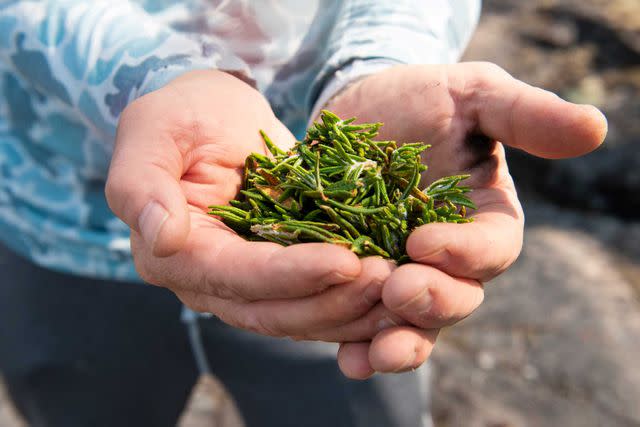
Pat Kane
Labrador tea leaves gathered on a small island in the lake.As part of his service, Ron offers guided backwoods camping, meaning he’ll bring you by motorboat wherever you want to go, set up the tents, cook, and guide you to the fish. If I could have, I would have pitched a tent out there. There are almost limitless places to camp. The land is fairly open, and much of the granite is flat. In many spots the rock juts out into the lake, where you can catch a breeze from either direction (which is helpful, because the black, deer, and horse flies are fierce), but there is enough tree cover to offer protection if the wind comes up. (Breezes on Great Slave Lake are good. Wind, on the other hand, can be terrifying.)
For me, it was a profound and comfortingly familiar feeling to be on the boat with my fellow Natives in a place that was, broadly speaking, ours. The park was created, to a large degree, because of Indigenous power.
For me, it was a profound and comfortingly familiar feeling to be on the boat with my fellow Natives in a place that was, broadly speaking, ours. The park was created, to a large degree, because of Indigenous power. It was something the bands in the area wanted (not exclusively, not completely, not in pure consensus) because the park protected their sacred lands. Aside from subsistence fishing and hunting and commercial fur trapping, there is little else that could be called industry in this part of the Northwest Territories, with the notable exception of gold, diamond, and uranium mining. When I brought up mining to Ron, he shrugged. “If they opened all this up to mines it would be destroyed and we’d be rich for maybe 20 or 30 years. After that? We’d be right back where we’ve been.”
The park is the answer: it protects the land, and it could — though it doesn’t yet — bring in revenue in the form of entrance fees, guided trips, and other travel services. And while there are no singular features that epitomize the park, no good place to take a selfie for the “gram” and then move on, it offers something much more profound: a landscape that is almost untouched, that exists as it has existed since the last ice age. Thaidene Nëné is one of the few places on earth that can offer this. You could have stood on a cliff 10,000 years ago and it would have looked very much the same as it does today.
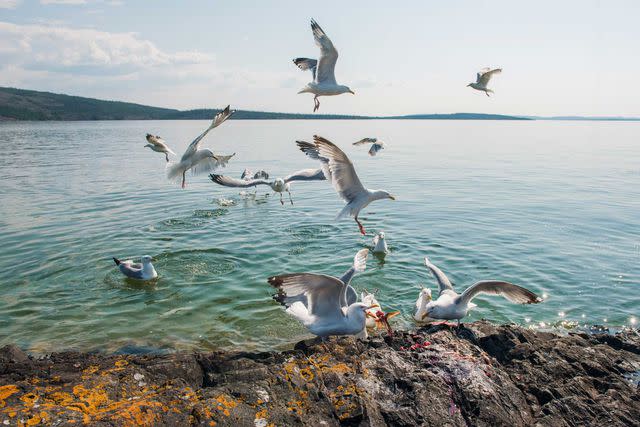
Pat Kane
Seagulls scavenge for fish scraps near Łutsël K’é.Frontier Lodge has its own pleasures. A snug cabin and comfortable mattress were luxuries I definitely didn’t object to. Neither was the happy hour. I ate better at the lodge than I do in my normal life: barbecued ribs, chicken parm, steak. Each morning, the guides would take guests out in twos to different parts of the lake. At noon the guide would cook a “shore lunch,” a uniquely Canadian fishing-lodge tradition. From coolers and totes would emerge potatoes, breading, and sausage, and in a matter of minutes a meal would be conjured from the campfire. More fishing followed.
Since the sun doesn’t go down until almost never, the evenings can be spent fishing, too, though boats have to be off the water by 10 p.m. The species in the Stark, a mile-long river that separates the lodge from Łutsël K’é, is Arctic grayling, a gorgeous salmonid much smaller than lake trout and an absolute blast to catch. In fast water, the fish hit hard on nearly any shiny thing. After dinner I could have walked down to the river in waders and fished as late as I wanted to. I didn’t do this, but I should have.
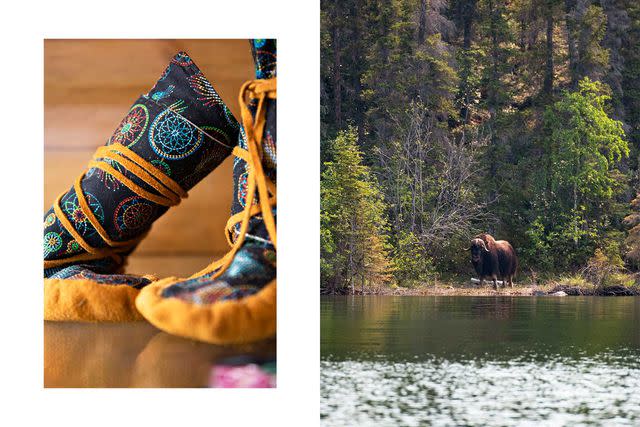
Pat Kane
From left: Moose-hide beaded moccasins on display in the Łutsël K’é Dene First Nation’s office; a musk ox on the shore of Moose Bay, near Yellowknife.On my second day, Ron, Pat, and I set off to see more of the park. The weather was uncommonly hot and still for a place just below the Arctic Circle that is iced over for eight months of the year. (While the park is officially open year-round, planes with tourists arrive mainly in the summer.) When the prevailing winds hit from the west and north, the lake can be extremely dangerous, with rollers and breakers up to four feet high.
We, however, headed out into dead calm. Even so, as we approached Christie Bay — more than 12 miles of open water — Ron muttered a few times that it would have been good to pack tents and sleeping bags “just in case” the weather turned and we couldn’t make it back. It was impossible to ignore the simple fact that, were the boat to flip, we’d be dead.
Related: Canada's Kluane National Park Is a Remote Adventure Paradise With Glaciers, Hiking, and Rafting
We made it across peacefully, even meditatively — there’s nothing like an outboard motor and the gentle nodding of the bow on glassy water to make you think about the infinite. We passed Fortress Island and dropped into the Gap, a small narrows with towering bluffs on either side. We immediately began catching fish. Everything about Thaidene Nëné made me feel like I had somehow stepped into the Upside Down: night was day, the fish were often too big to eat, the fishing lodge was owned by Native people and staffed by non-Natives, there was rock where there was supposed to be trees, and trees where I expected rock.
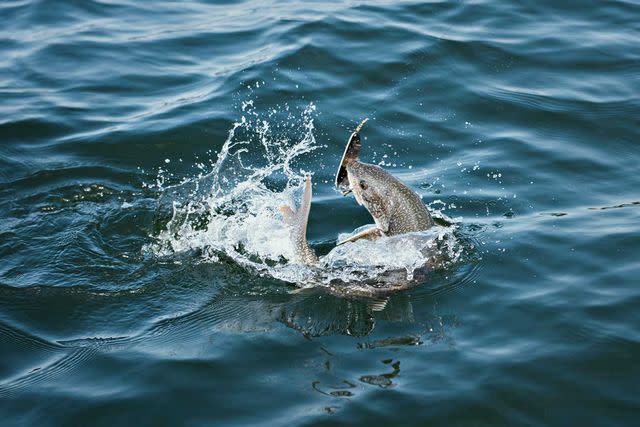
Pat Kane
Trout in Great Slave Lake.As my stay wound to an end, we fished less and did more sightseeing. We went to Red Cliffs — sheer slabs of reddish stone rising a few hundred feet above the lake — and stopped into Łutsël K’é. With around 350 residents, the settlement doesn’t have much in the way of development: tribal offices, a few municipal buildings, a community center, warehouses, around 80 houses, a diesel-powered generator, and the Co-op, which is the only place to buy groceries, gas, and household goods.
People seemed to come and go a lot. It’s one of the paradoxes of isolated northern communities: they are so far from anywhere else, and yet people are in a state of perpetual arrival and departure. Every fly-in spot in a reserve is a hub for even smaller, scattered settlements. It was this way from the early days, before the arrival of Europeans; it remained so during the fur trade and, later, the early years of mineral exploration.
The park offers something much more profound: a landscape that is almost untouched, that exists as it has existed since the last ice age. Thaidene Nëné is one of the few places on earth that can offer this. You could have stood on a cliff 10,000 years ago and it would have looked very much the same as it does today.
I imagine it will be no different should the number of visitors to the park increase, which I both hope it does and hope it doesn’t. I liked that there was so little signage and no improved trails or historical markers or lines of people or long strings of motorcycles or bottlenecks or gatehouses or ice cream shops or key chains or commemorative T-shirts. I liked very much what I saw instead: people loading and unloading boats with hunting rifles, gill nets, bags of groceries; always at least one person just hanging out in front of the Co-op; clusters of Ni Hat’ne Dene Guardians and territorial and Parks Canada employees chatting and teasing each other; a guy at the dock who, when I offered him my sandwich, took it and chatted with me a little even though I didn’t really understand anything he said (it could have been that he was speaking Dene or it could have been the sandwich); the dogs that slid between groups of people and houses on some mission or another.
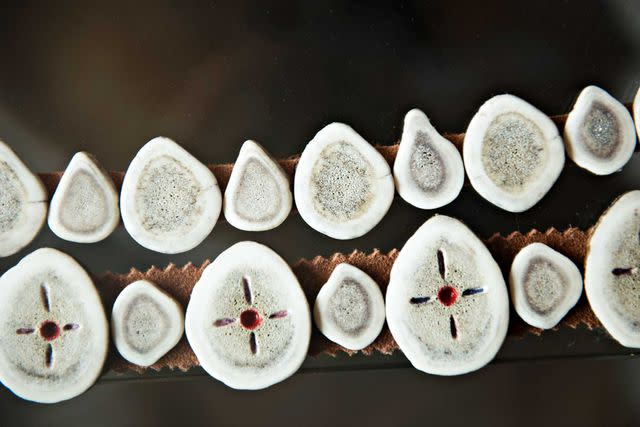
Pat Kane
A caribou-bone hat band on display in the Łutsël K’é Dene First Nation’s office.And then it was our last night: a sauna and, finally, the musk ox seasoned and grilled over the fire, along with trout “nuggies,” breaded, deep-fried, and coated in Frank’s Red Hot. Easily the best meal at the end of a week of great food.
When the plane took me out the next day it was rainy and the bugs were bad. Once on board I got to see the lake in reverse: first, great fingers of land with cliffs shooting straight down to the water’s edge, and then, over the land itself, small lakes scattered like coins in a giant lap of granite. I felt as I always do when flying over the Canadian Shield — filled with regret that I was there for only a few days.
Time in the North can’t be bought with such small change. One would need a year, two, 10, a lifetime to know even a small portion of it. So I felt regret that I was leaving and heading south, where the land is more forgetful — because everything gets covered up with growth eventually — and more pliable for being so. Back south to where the hand of man is heavier and more visible. Regret as I looked out the window at all the beauty and mystery — unknown, unexplored, unlived by me — that I wouldn’t get to solve. Until the next time.
Fishing packages at Frontier Fishing Lodge, which include accommodations, meals, guided fishing, ground transportation, and round-trip charter flights from Yellowknife, start at $2,750 for three days.
For more Travel & Leisure news, make sure to sign up for our newsletter!
Read the original article on Travel & Leisure.

